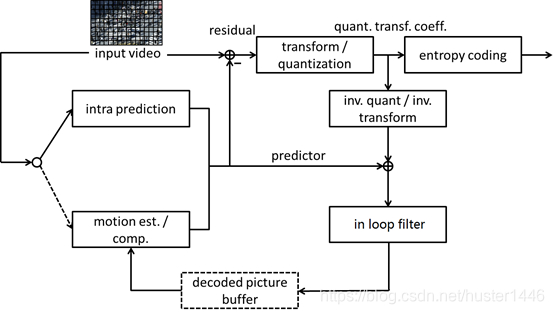所有描述均基于vtm4.0版本,本文主要是翻译JVET-M1002文档
编码框架
和之前的标准类似,VVC采用基于块结构的混合编码框架,融合了帧内和帧间预测、变化编码和熵编码等模块。如下图:

VVC通过块划分将一帧图像划分成许多编码树单元(coding tree unit,CTU)。一个CTU通过内嵌多类型树的四叉树结构(a quadtree with nested multi-type tree using binary and ternary splits segmentation structure)被划分成许多编码单元(coding unit,CU)。每个子CU(leaf coding unit)可以使用帧内预测或帧间预测,也就是说决定帧内还是帧间是在CU级。注:单元(unit)是指图像中某个区域,包含所有的色彩分量。而块(block)则是指包含某个特定色彩分量(如亮度luma分量)的图像区域。对于一个CU,包含亮度分量的CB( coding block)和两个色度分量的CB。
新特性
VTM4中包含了很多其他的新特性,遍及帧内帧间预测、变换量化、熵编码和环路滤波过程。在11次JVET会议过后,以下的新特性已经被应用到VTM3上:
帧内
1、67种帧内预测模式以及扩展的宽角度模式(67 intra mode with wide angles mode extension)
2、基于块大小和模式的4抽头插值滤波器(Block size and mode dependent 4 tap interpolation filter)
3、位置决定的联合预测(Position dependent intra prediction combination,PDPC)
4、跨组件的线性帧内预测模型(Cross component linear model intra prediction, CCLM)
5、多参考线帧内预测(Multi-reference line intra prediction,MRL)
6、帧内子划分(Intra sub-partitions, ISP)
帧间略(本人主要做帧内,有时间再翻译)。
变换量化及系数编码
1、多种变换方式选择(Multiple primary transform selection with DCT2, DST7 and DCT8)
2、子块变换(Sub-block transform)
3、最大QP从51变为63(Dependent quantization with max QP increased from 51 to 63)
4、变换系数编码时隐藏符号数据(Transform coefficient coding with sign data hiding)
还有其他环路滤波等屏幕内容和360度视频编码等新特性,不一一列举。
